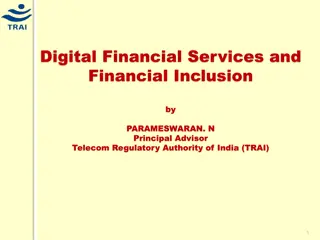Banking Risks and Responses in Today's Financial Landscape
Anjan Thakor, Interim Dean at Wash U. Olin Business School, discusses various banking risks such as tension between fiscal and monetary policies, cyber security, rising consumer indebtedness, war and geopolitical risks, and more. The article explores how these risks can become systemic and suggests ways for banks to respond, emphasizing the importance of early-warning indicators and bank capital. Regulatory and supervisory responses are also highlighted, showcasing the significance of market-based indicators in crisis management.
Download Presentation

Please find below an Image/Link to download the presentation.
The content on the website is provided AS IS for your information and personal use only. It may not be sold, licensed, or shared on other websites without obtaining consent from the author. Download presentation by click this link. If you encounter any issues during the download, it is possible that the publisher has removed the file from their server.
E N D
Presentation Transcript
FRONTIER AND OTHER BANKING RISKS ANJAN THAKOR Interim Dean Wash U Olin Business School Views are my own and do not reflect any positions of the Olin Business School or Washington University in St. Louis.
RISKS ON THE RADAR (1) Tension between fiscal and monetary policies (2) Political polarization and potential politicization of policy (3) Cyber security (4) Rising consumer indebtedness ( 60/40 debit/credit to 40/60 debit credit cards)
FRONTIER RISKS (1) War and geopolitical risks (2) Social unrest as lack of trust in major institutions grows (3) Increasing crime , potential negative shocks to economic development, and increasing credit risks for banks (4) Collapse of trust in the financial system ( is FTX collapse a one-off or a tip of the iceberg?) .the international differences in credit card processing. See Bob Merton papers on trust in financial system. (5) Climate change risk policy /regulatory adaptation
WHICH COULD BECOME SYSTEMIC? Any of these risks could become systemic because the potential correlations across institutions are quite apparent. The more difficult question is: how might the manifestation of these risks affect other, more familiar, risks that could also become systemic?
HOW SHOULD BANKS RESPOND? (1) Dashboard of key early-warning indicators (2) Do not obsess about the probabilities ( very hard to estimate or agree on) but rather the magnitudes of losses, conditional on occurrence, and how long before the actual realization will early warning indicators start flashing? (3) Focus on bank capital ( evidence on 2007-09 crisis)
REGULATORY/SUPERVISORY RESPONSES Greater reliance on forward-looking market-based indicators Taylor and Williamson (2009) evidence that the LIBOR-OIS spread increased sharply in August 2007 and stayed high. Fed s 2008 liquidity injections did not lower the spread, but the spread declined when the US government began injecting liquidity in banks ( Thakor, JFS 2018). Rosengren point that if bank dividends had been frozen ( to augment capital) when LIBOR-OIS spread went up, it would have cut in half the capital the government ended up injecting in banks to resolve the crisis
RISKS OF SECOND-ORDER EFFECTS OF REGULATORY RESPONSES (1) Basel I risk weights in capital requirements and Fed s attempt to stimulate economy in late 1980s-early 1990s by flooding system with liquidity ..banks simply used it to buy Treasuries, and not increase lending (2) Climate change: what will happen if we push banks via regulation to favor green loans over brown loans? Topic for research (3) Spillover effects of crypto problems ( FTX bankruptcy) and potential regulatory responses























